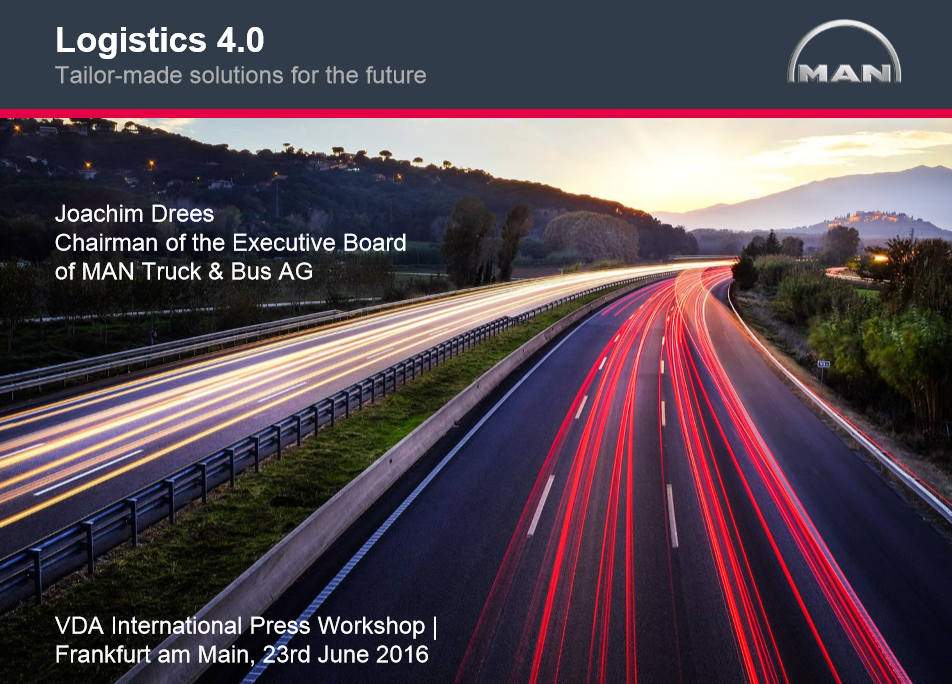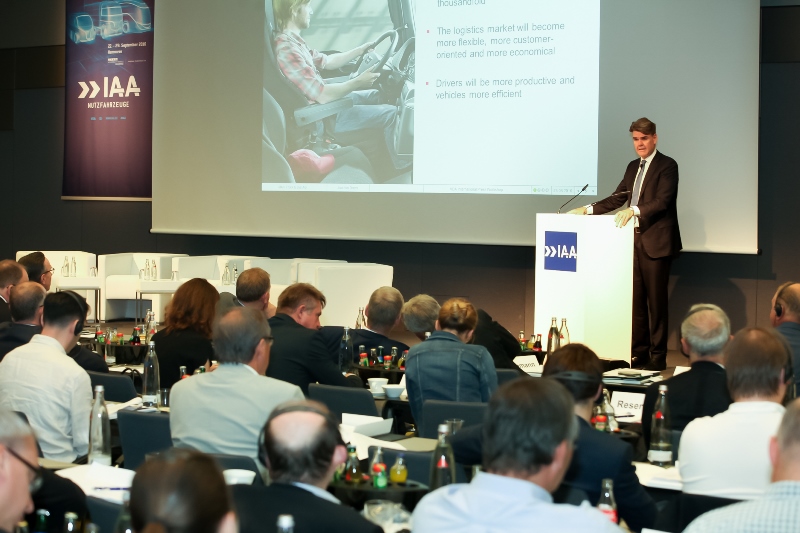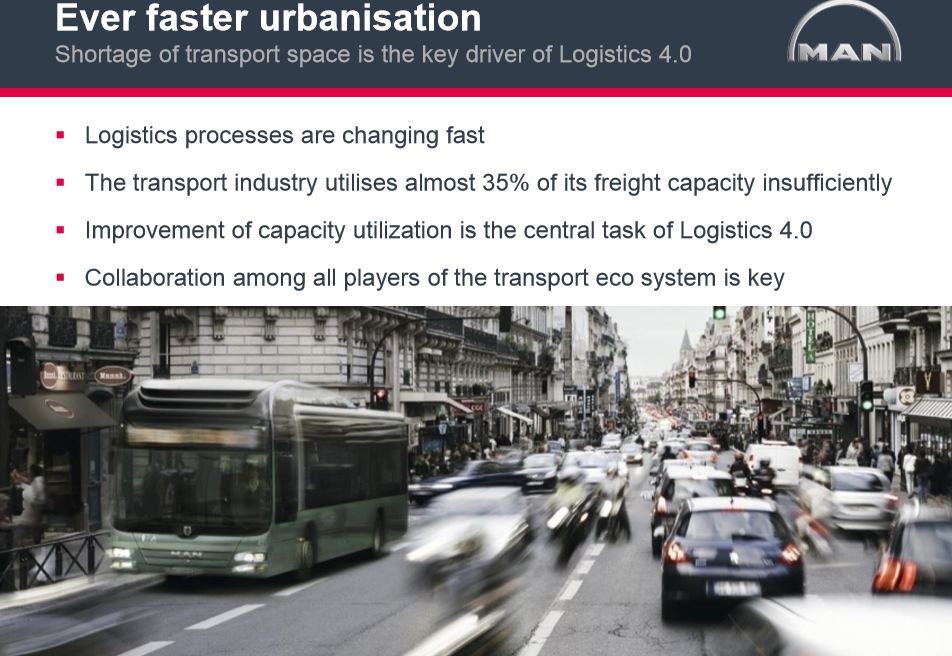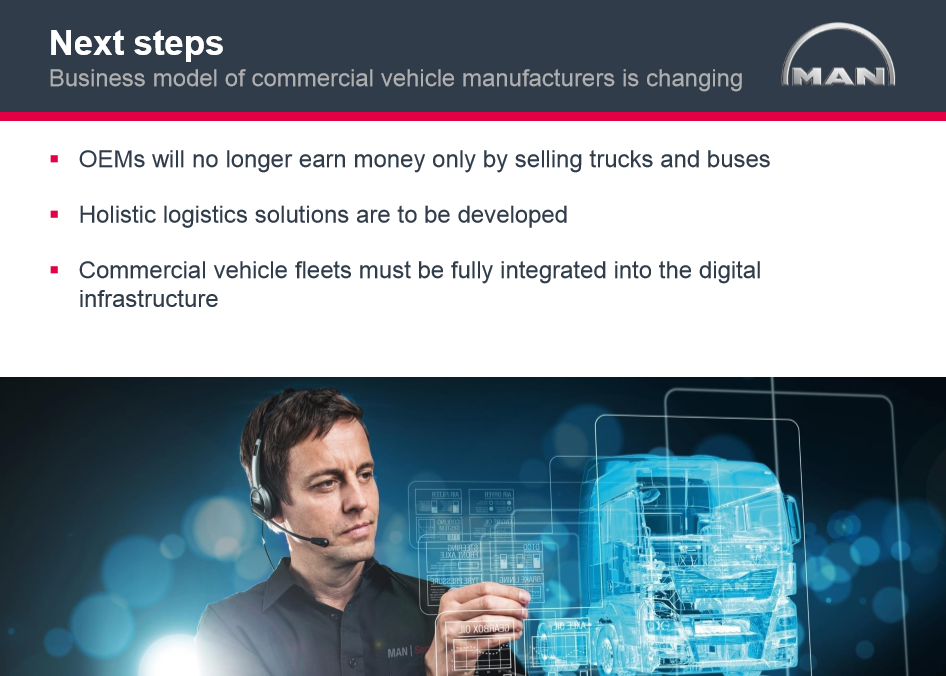Keynote address by Mr. Joachim Drees, CEO of MAN Bus & Truck AG at the International Press Workshop
The German Federal Government has put Industry 4.0 on its agenda. As you know, this concerns a model for the future of our business location: the digitalization of industrial processes. Digital networking is to become the foundation of more efficient and more flexible industrial production. Models like these must be based on tailored logistics solutions. This has consequences for the entire transport ecosystem. The prerequisite for Industry 4.0 is Logistics 4.0.
What are the challenges this sector is currently facing? Logistics 4.0 must support a highly developed division of labour. The key word here is collaboration: industry calls off goods and services globally as required. Stages of production are digitally coordinated. Processing is taken over by specialized partners. Trade expands with internet-supported business models. In this regard, vendors need fast, small-scale flows of goods to the consumers.
These trends make the transport ecosystem even more important to the industrial value-creation chain. The logistics sector has in the meantime become the third most important sector in the German economy. A workforce of 2.8 million generates revenue of more than 230 billion euros per annum. Our customers here are carrying out increasingly complex tasks. The requirements in terms of adherence to delivery deadlines and transport quality are increasing. The same applies to transparency. In many cases the documentation of logistics chains must be unbroken. The frame work conditions are also becoming more demanding. 75% of the German population now lives in urban environments. Since 2005, the annual traffic jam length has tripled to 1.1 million kilometres. Germany’s Ministry of Transport expects road transport to increase by almost 40% by 2030. The volume of transport by rail will actually increase by more than 40%. It is foreseeable that global urbanization will even accelerate. By 2050, six billion people will live in densely populated metropolitan areas. Even today, the scarcity of space for traffic is one of the main drivers in the development of Logistics 4.0.
How are logistics processes changing in this context? Both the transport and the loading industries are under pressure to act. They have to ensure a highly differentiated supply of goods and at the same time they have to go easy on resources, climate and environment. To do this, transport must be organized differently and more efficiently. Today, almost 35% of the transport industry’s freight volume cannot be used or can only be used inadequately. That is uneconomical and not particularly friendly towards the environment. Increasing the level of utilization is one of the major tasks facing Logistics 4.0. Powerful central planning systems are no longer sufficient for this purpose. Companies must work together more closely, regardless of the fact that they are in competition. We are assisted by real-time transport data and simple but effective communications solutions. Trucks and trailers are taking over an increasing number of functions as collectors of data and suppliers of information. They’re able to keep materials requirement planners, loaders, recipients and trans-shipment terminals automatically informed. This makes cooperation and coordination between participants considerably more straight-forward.
What are the prerequisites for this? Above all, Logistics 4.0 needs functioning interfaces. Systems that cannot be integrated have no future. Germany’s National Academy of Science and Engineering has stated what is required:
standards for AutoID and sensor data
standards for data exchange between vehicles
standards for the integration of traffic data into logistics management and
standards for open, service-orientated logistics platforms.
The regulations must be defined jointly by logistics companies and commercial vehicle manufacturers in the very near future. Only in this way will we maintain control over the data on which the new business models in logistics are based. Only by doing this can we, and not some third party, continue to take responsibility for shaping Logistics 4.0 ourselves. Only by doing this do we make data protection a decisive feature of the quality of our solutions and services.
What will the logistics chain of the future look like? Many of the players still have no clear ideas about this. But it’s surprisingly simple. Every step of the transport becomes transparent for every participant. Where are the vehicle and the cargo rights now? What is the current status? Is the vehicle moving or stationary? When will it arrive and where? What must be initiated next? Vehicles and transport units record the requisite data. They automatically forward relevant changes. Those vendors who are able to make use of such information will establish a lead on the logistics market. This capability will make them more flexible, better orientated towards the customer and more cost-effective. The customers of the commercial vehicle manufacturing industry need vehicles and services that help them maintain this lead. They need system solutions that enable drivers to work more productively and vehicles more efficiently. The German Logistics Association (BVL) estimates that the amount of data generated in logistics will increase thousand fold over the next ten years. Business and politics have to create suitable framework conditions for this right now. Data exchange related to traffic and the mobility of goods must be converted to the standardized Internet protocol. 4G broadband supply along all major transport routes will be indispensable.
In long-haul transport in particular we can make decisive improvements to safety, cost effectiveness and efficiency. The focus here is on intelligent solutions for networked and automated driving. However, development and testing won’t be completed overnight. Amending the European legal framework also takes time. But the majority of our customers expect networked solutions from us here and now. As the initial step, they want to be able to link offers more simply and be able to use them better.
What does the entry of the commercial vehicle manufacturers into Logistics 4.0 look like? What we as commercial vehicle manufacturers want is simple, better solutions for our customers. In concrete terms, we’re interested in low fuel consumption, greater vehicle availability and better utilisation of capacity. The vehicle’s location, fuel consumption, wear on parts and a lot more operating data are already being recorded in real time today which can be evaluated by remote analysis. This creates a quantifiable added value for the customer. Examples of these are failure prediction, the selection of workshops along the route as well as the monitoring of driving times and rest periods. Furthermore, vehicle-specific data analysis is used for coaching individual drivers. Supported by mobile telephony, this service can be offered ‘on the job’, that is, while the vehicle is being driven. Participants in field trials saved 2.3 litres of diesel fuel per 100 kilometres on average. They also put measurably less strain on their vehicles. Now is the time for us, together with the transport companies, to expand the digital based service offer. The most important topic we have to tackle jointly in this context is optimizing the utilization of vehicle capacity. As you know, income in the transport industry isn’t as good as it could be. What consignors, transport companies and drivers all need is comprehensive information in real time:
When will how much loading capacity be available where?
Where does a consignor need loading capacity?
When and for which destination?
What prices are currently being asked and offered?
A real-time marketplace for transport capacity was discussed at the National IT Summit 2015. An improvement of 25% due to interactive goods management in real time is a realistic goal. This is where we as automotive manufacturers can display our competence as service providers. And that’s what we’re going to do, in fact, we’re going to do it in close cooperation with our customers.
What do the next steps look like? In future, commercial vehicle manufacturers will not generate income solely from the sale of trucks, buses and coaches. The percentage of operative business generated by services will rise very quickly and significantly. We are addressing a dynamically expanding target market for holistic, intelligent logistics solutions. To this end, practically all fleets of commercial vehicles must be integrated into a comprehensive digital infrastructure in the shortest space of time. We must expand our business area very swiftly, with great motivation and with the courage to undertake fundamental changes. Only if we do this will we meet the demands of our customers. The transport industry needs service offerings from us that enable it to manage flows of goods effectively. It needs solutions to reduce the complexity of Logistics 4.0. Both of these contribute to making the transport ecosystem as socially responsible and environmentally friendly as possible and at the same time, as cost-effective as possible. With the latest cloud technology we can offer the short innovation cycles and fast reactions that our customers expect. Coupled with this is the obligation to implement the most stringent data protection standards. Logistics 4.0 confronts us with the task of enabling the data from the transport ecosystem to be put to optimal use by our customers. At this point I recall to mind the key word I used at the beginning: ‘collaboration’. I personally have the will to collaborate. I’m convinced that we will organize ourselves properly and sustainably. I look forward to working with you.



